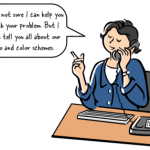
Your rapid elearning software makes it easy to record your narration. Most of the time that works for you. However, there are times when recording your own narration doesn’t make sense. Today we’re going to look at when it makes sense to consider professional narration for some of your elearning courses.
A Good Voice Doesn’t Equal Good Results
“Why pay for professional narration? Joe and Samantha have good voices. Let’s get them to do it.” On the surface, this sounds like a good plan. But that might not be the case.
- Joe and Samantha have good voices but they aren’t professional narrators. It takes more than just a good speaking voice to get the inflections and tone right. Because of this, using Joe and Samantha requires a lot more time and retakes to get it right.
- Your recording equipment consists of a headset microphone and a less-than-state-of-the-art laptop. And your “recording studio” is a spare conference room. There’s a lot of ambient office noise and a really loud air conditioner.
- Since you’re probably not an audio expert, you are less efficient when you record. You can’t monitor the audio while you’re recording, so you only record a portion at a time. Stop. Listen to it. Re-record. Stop. Listen to it. Re-record. And so forth.
- You publish your course and send it out for review. Despite mentioning the limitations of using in-house talent, you find that your client is not pleased with the quality of the audio. It turns out that Joe suffers from the “popping P’s” and Samantha the snake hisses with her S’s. On top of that, the air conditioner added a distracting hum throughout the entire audio track. Your choice is to re-record or spend a lot of time trying to “edit it out.”
These are typical issues when recording your own narration. Using in-house talent will usually cost you more time and produce lower quality. For some projects, that’s OK and you can live with the results. However, it’s not always the best course of action.
Here’s How Much Your Narration Costs
Sometimes your hands are tied and you have to work with what you have. While your client or manager might think they’re saving money, the fact is that they probably don’t know for sure. Many places don’t do a good job tracking the real costs of projects. If you don’t know what you’re spending, how do you know if you’re saving money?
Rapid elearning development has a 33:1 ratio in development time. For every finished hour, you’re probably spending about 33 hours of work in labor. I’m just going to keep it simple and say that it takes you a week to do a project. That’s 40 hours. At $100* per hour, the company is spending about $4000 per project. That’s just for your labor.
Now let’s look at the recording session. Let’s say you get all of the recording done in two hours (a very low estimate). It’s just you and your voiceover talent. While you have two hours of recording time, you also have to factor in the time to prepare and some incidental time. It’s not like you just stop your work and teleport to the conference room and then teleport right back.
We’ll say that the two hours of recording also includes an extra hour of prep time. So, two people at three hours equals six hours of labor. At $100 per hour, you’re looking at $600 just to do the recording. This doesn’t include the lost productivity of using in-house talent.
Because you’re doing the recording yourself, you’ll have increased edit and review time. If you run some quick estimates, I’m sure that you’ll find that you’re easily spending over $1000 for your free narration. And you’re still making compromises on the quality.
How Do These Numbers Compare to Hiring a Pro?
It used to cost a lot more to get professional narration. That’s no longer the case. Today you can use a number of online services to post projects, screen the talent, and hire just the person you need. And you can do so at a great cost.
In fact, most of the projects I’ve done recently have come in well under $500. I found that not only am I getting good narration, I’ve eliminated a lot of labor because I don’t have to edit a bunch of audio files.
Most of the sites have a very simple and straightforward process. You submit a project, set a budget, and request an audition. I’ve had a lot of luck finding good vocal talent at very reasonable costs. And the turnaround is very quick.
You can set a budget limit to make sure you don’t spend more than you can afford. You’d be surprised. I’ve submitted some projects that had a very low budget, but it seems there’s always someone willing to do the work. Not only do I control my costs, most of the time I get the audio back within a day or two.
Of course the cost of your narration depends on how long it is and what you want. I have submitted large projects and small projects. Most of the smaller ones have been well below $500. However, some of them have been much more. Submit a script, give them your budget, and then see what happens.
When Do You Go with a Pro?
The main consideration is your project scope. If it’s a short course with a limited audience (and the narration quality is not an issue), then it makes sense to keep it in-house. Why spend money you don’t need to? However, if it’s a course intended for a larger audience, then it makes sense to consider using professional narration.
If it’s a course that is going to reach your customers or go outside of the organization, I recommend getting the best narration you can afford. An exception is if the narrator is a personality or authority that the audience expects to be part of the course.
Another benefit to working with a professional service is that it forces you to be more disciplined with your script. You won’t have the luxury of doing multiple retakes because it will cost more. And speaking of retakes, if you find you want to do audio edits down the road, having the pro audio makes it easier to seamlessly blend different recording sessions because the audio levels and quality is controlled.
Once you do a few projects, you’ll develop relationships with some regulars. Because we know each other (and they know I will pay), I find that I get the projects faster and a little less expensive. I can shoot off a quick email and get a bid in no time at all. I trust them and know that I’ll get a quality product. That saves me a lot of time.
It’s true that professional narration isn’t an option for everyone. Plus, some of you are quite capable and able to handle the audio recording yourselves. However, I think you’d be surprised when you look at your real costs and compare it to what you can get with some of today’s services. You might find that professional narration isn’t as expensive as you originally thought. On top of that, you end up with a much higher quality product which probably lends itself to a better learning experience.
What do you think? Do you agree? Disagree? Feel free to share your thoughts by clicking on the comments link.
Events
Free E-Learning Resources
















0
comments